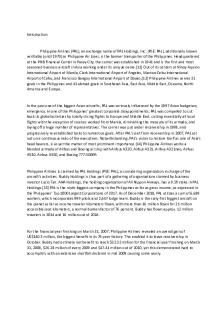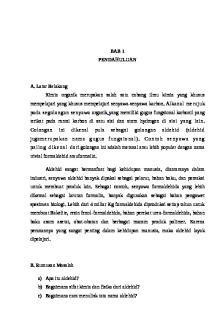Sunup Papaya paper PDF

| Title | Sunup Papaya paper |
|---|---|
| Course | Biology Of Plant Food Systems (Biol) |
| Institution | University of Minnesota, Twin Cities |
| Pages | 2 |
| File Size | 68.5 KB |
| File Type | |
| Total Downloads | 88 |
| Total Views | 139 |
Summary
U1-1: SunUp and Rainbow Transgenic Papayas...
Description
Agro 1101 8 February 2017 U1-1: SunUp and Rainbow Transgenic Papayas The Carica papaya are trees that can live for fifteen or more years, and produce large fruit that can be consumed year-round. Papayas originated in Central America, and have since been distributed throughout every tropical and subtropical climate. The most prominent producers of papayas are India, Brazil, and Indonesia (FAOSTAT, 2012); in the US, papayas have become an important export crop in Hawaii since the mid-1940s. Breeding in Hawaii resulted in a cultivar, ‘Kapoho’ or Sunset, which had larger fruit grown low on the trunk. Major papaya growing areas Puna and Hilo led to 47% of Hawaii’s papayas to be consumed locally, 21% exported domestically, and 32% exported to foreign countries (Fitch et al., 1992). However, several diseases affect papaya production. The most detrimental disease is a potyvirus called Papaya ringspot virus (PRSV), of which C. papaya is not resistant. PRSV symptoms include lightening leaf color and eventual mottling, misshapen fruit with ringspots, lowered yield, and eventual collapse of the tree. PRSV is fatal to papaya trees (Jensen, 1949). Aphids spread the virus, but controlling aphids is not enough to prevent the infection from spreading unless infected trees are removed immediately (Namba and Kawanishi, 1966). PRSV posed a huge threat to Hawaii’s papaya industry when the growing center Hilo experienced PRSV infections. Puna, the largest growing area, was only fifty kilometers away from Hilo. The industry could have been devastated by a serious infection of PRSV in Puna. The approach to control PRSV was known as cross protection, defined by Gonsalves as “the phenomenon wherby plants that are systemically infected with a mild strain of a virus are protected against the effects of infection by a more virulent related strain” (2016). By treating a severe Hawaiian strain of PRSV with nitrous acid, a mild strain was created. A team of biotechnologists at the University of Hawaii and Cornell University cloned and engineered the coat protein gene of the mild strain and transferred the gene into the Sunset papaya. By 1991, they had a transgenic papaya line, 55-1, that resisted PRSV. A field trial of cloned 55-1 plants proved resistance in field conditions. However, it wasn’t soon enough; PRSV had reached Puna in 1992, and by 1994 the papaya industry was suffering. The researchers used the field trial plants to develop a cultivar with the coat protein gene in its homozygous state. ‘SunUp’ was the name of this transgenic line. When co-cultivated with the local cultivar Sunset, they produced ‘Rainbow’. A field test proved that these transgenic Rainbow plants were resistant to PRSV (Ferreira et al., 2002). EPA and FDA deregulated the transgenic line 55-1, including SunUp and Rainbow, and in 1998, SunUp and Rainbow seeds were distributed to papaya growers in Hawaii. Transgenic papayas make up 85% of Hawaii’s papaya industry, and PRSV resistance has continued. In 2003, Canada deregulated transgenic papayas, and much later, in 2011, Japan deregulated Rainbow papayas. However, most exports include non-transgenic fruit. This is only accomplished partly as a result of PRSV-buffering effect, which is when transgenic papayas surround non-transgenic plantings, allowing aphids that carry PRSV to “rid their mouth parts” of the virus before continuing on to the non-transgenic trees
harmlessly (Fitch, 2016). In East and Southeast Asia, PRSV as well as other potyviruses still affect papaya production; the Hawaii experience with transgenic papayas shows the value of research prior to outbreaks and immediate adoption of transgenic alternatives as a successful reaction to PRSV infections. Sources Drew, R., Fitch, M., Zhu, J., Sanewski, G., & Honsho, C. (2016). Proceedings of the IV International Symposium on Papaya, VIII International Pineapple Symposium, and International Symposium on Mango: Brisbane (Qld.), Australia, August 1722, 2014. Leuven: ISHS. Retrieved from http://www.actahort.org.ezp3.lib.umn.edu/books/1111/index.htm FAOSTAT. (2012). http://www.faostat. Ferreira, S.A., Pitz, K.Y., Manshardt, R., Zee, F., Fitch, M., and Gonsalves, D. (2002). Virus coat protein transgenic papayas provides practical control of Papaya ringspot virus in Hawaii. Plant Dis. 86 (2), 101-105 Jensen, D.D. (1949). Papaya virus diseases with special reference to papaya ringspot. Phytopathology 39, 191-211. Namba, R., and Kawanishi, C. (1966). Transmission of papaya mosaic virus by the green peach aphid. J. Econ. Entomol. 59(3), 669-671 http://dx.doi.org/10.1093/jee/59.3.669....
Similar Free PDFs

Sunup Papaya paper
- 2 Pages

La Papaya Wikipedia
- 20 Pages

Pal-paper - PAL PAPER
- 3 Pages

Paper
- 11 Pages

Observation Paper (RESEARCH PAPER)
- 13 Pages

dse sample paper paper 1
- 19 Pages

Paper aldehid
- 14 Pages

Reflection Paper
- 2 Pages

Reaction Paper
- 2 Pages

Paper karangsambung
- 11 Pages

Laspo Paper
- 28 Pages

W1 Paper
- 7 Pages
Popular Institutions
- Tinajero National High School - Annex
- Politeknik Caltex Riau
- Yokohama City University
- SGT University
- University of Al-Qadisiyah
- Divine Word College of Vigan
- Techniek College Rotterdam
- Universidade de Santiago
- Universiti Teknologi MARA Cawangan Johor Kampus Pasir Gudang
- Poltekkes Kemenkes Yogyakarta
- Baguio City National High School
- Colegio san marcos
- preparatoria uno
- Centro de Bachillerato Tecnológico Industrial y de Servicios No. 107
- Dalian Maritime University
- Quang Trung Secondary School
- Colegio Tecnológico en Informática
- Corporación Regional de Educación Superior
- Grupo CEDVA
- Dar Al Uloom University
- Centro de Estudios Preuniversitarios de la Universidad Nacional de Ingeniería
- 上智大学
- Aakash International School, Nuna Majara
- San Felipe Neri Catholic School
- Kang Chiao International School - New Taipei City
- Misamis Occidental National High School
- Institución Educativa Escuela Normal Juan Ladrilleros
- Kolehiyo ng Pantukan
- Batanes State College
- Instituto Continental
- Sekolah Menengah Kejuruan Kesehatan Kaltara (Tarakan)
- Colegio de La Inmaculada Concepcion - Cebu



